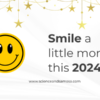How to make your New Year resolution stick

Every year during the New Year time I diligently made a post on ‘New year’ resolution. This year also I thought I must do the same. But then, I felt that it would be untruthful of me to write one more on this as I myself do not stick to the resolutions I make year on year.
So instead of writing about ‘New year’ resolution, this year I will write about How to make your New Year resolution stick
I will take help from two books namely Carrots and Sticks Don’t Work by Dr. Paul Marciano and Atomic Habits – An Easy & Proven Way to Build Good Habits & Break Bad Ones by James Clear and propose some simple strategies that should surely help me and you stick to new year resolution this time.
Do not set just goals, but set SMART goals
Do not say you will quit smoking or lose weight or cut down your mobile phone usage, but clearly set a measurable, achievable, relevant, and time-bound goal like I will run 3Km a day or I will reduce 10Kg in 6 months’ time period or I will reduce the number of hours I spend scrolling phone by 2 hours.
Start Small
Usually on January 1st you would start with the goal setting and you will achieve the task. In the next two weeks’ time, you would slowly start going back to your old self. This is because it’s not easy to make big changes drastically and stick to them. For a change to stay with you, it should become a habit. For something to become a habit that was not part of your system, you will have to start small. According to James Clear, minuscule adjustment can create “atomic habits,” which lays the foundation for extraordinary outcomes. So in addition to setting the goal, outline a process made up of many small steps to attain it.
Make it ‘Attractive’
You tend to repeat a task if it gives you pleasure. As you know in the state of pleasure brain releases dopamine. So it’s easier to form a habit if the activity is attractive. According to Clear, to increase the attractiveness of a new habit, couple an activity “you want to do” with an activity “you need to do” – this is called “temptation bundling.” For example, bundling watching Netflix (the thing you want to do) with riding a stationary bike (the thing you need to do). Temptation bundling is one way to apply a psychology theory known as Premack’s Principle. Named after the work of Professor David Premack, the principle states that “more probable behaviors will reinforce less probable behaviors.”
Opt for ‘Habit Stacking’
Habit stacking is a special form of implementation intention. Rather than pairing your new habit with a particular time and location, you pair it with a current habit. This method, which was created by BJ Fogg as part of his Tiny Habits program.
The habit stacking formula is: After/Before [CURRENT HABIT], I will [NEW HABIT].
Habit stacking will help you in sticking with your plan as you are tagging the new activity to a habit that is already built into your brain. Once you learn to do one activity with a regular habit, you can begin to create larger stacks by chaining many such small habits together. Your morning routine habit stack might look like this:
After I brush my teeth, I will drink a glass of lukewarm water
After I drink a glass of lukewarm water, I will do my exercise
After I finish my exercise, I will read the newspaper
Realize that progress is never linear. Have Patience
One thing you should keep in mind, whether you are working on your healthy diet, fitness goals, career objectives, is to remember that progress is not going to be linear. When working on your goals, you need to always remember “The Iceberg Illusion.” This concept was created by Sylvia Duckworth, and it explains how when looking at other people’s accomplishments, we tend to look at their accomplishments or the tip of the iceberg, and how we conveniently ignore what’s below the surface; which includes persistence, disappointment, discipline, dedication, sacrifice, failure, and all the hard work required to meet the end goal. To achieve the progress you desire, it would need hard work, discipline, and persistence.
Finally, anyone can set goals, but only the one who has clearly broken down the goal into small milestones and who shows the persistence to stay on course what may come would only achieve the goal.
Happy new year to you








